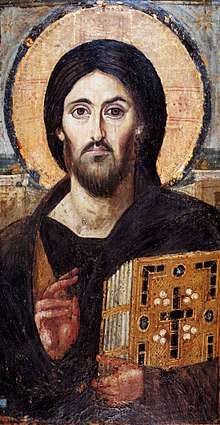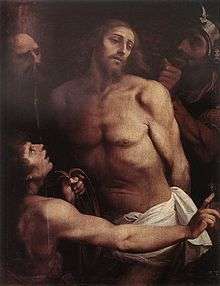Christ (title)
The concept of the Christ[note 1] in Christianity originated from the concept of the messiah in Judaism. Christians believe that Jesus is the messiah foretold in the Hebrew Bible and the Christian Old Testament. Although the conceptions of the messiah in each religion are similar, for the most part they are distinct from one another due to the split of early Christianity and Judaism in the 1st century.

| Part of a series on |
| Christianity |
|---|
 |
|
|
|
Christ, used by Christians as both a name and a title, is synonymous with Jesus.[5][6][7] It is also used as a title, in the reciprocal use "Christ Jesus", meaning "the Messiah Jesus", and independently as "the Christ".[8] The Pauline epistles, the earliest texts of the New Testament,[9] often refer to Jesus as "Christ Jesus" or "Christ".[10]
Although the original followers of Jesus believed Jesus to be the Jewish messiah, e.g. in the Confession of Peter, Jesus was usually referred to as "Jesus of Nazareth" or "Jesus, son of Joseph".[11] Jesus came to be called "Jesus Christ" (meaning "Jesus the Khristós", i.e. "Jesus the Messiah" or "Jesus the Anointed") by later Christians, who believe that his crucifixion and resurrection fulfill the messianic prophecies of the Old Testament.
Etymology
Christ comes from the Greek word χριστός (chrīstós), meaning "anointed one".[12] The word is derived from the Greek verb χρίω (chrī́ō), meaning "to anoint."[12] In the Greek Septuagint, christos was used to translate the Hebrew מָשִׁיחַ (Mašíaḥ, messiah), meaning "[one who is] anointed".[13]
In the Old Testament, anointing was reserved to the Kings of Israel[14], to the High Priest of Israel (Exodus 29:7, Leviticus 4:3–16[15]), and to the prophets (1 Kings 19:16).[16]
According to the Summa Theologica of Thomas Aquinas, in the singular case of Jesus, the word Christ has a twofold meaning, which stands for "both the Godhead anointing and the manhood anointed". It derives from the twofold human-divine nature of Christ (dyophysitism): the Son of man is anointed in consequence of His incarnated flesh, as well as the Son of God is anointing in consequence of the "Godhead which He has with the Father" (ST III, q. 16, a. 5).[17]
Usage

The word Christ (and similar spellings) appears in English and in most European languages. English-speakers now often use "Christ" as if it were a name, one part of the name "Jesus Christ", though it was originally a title ("the Messiah"). Its usage in "Christ Jesus" emphasizes its nature as a title.[8][18] Compare the usage "the Christ".
The spelling Christ in English became standardized in the 18th century, when, in the spirit of the Enlightenment, the spelling of certain words changed to fit their Greek or Latin origins. Prior to this, scribes writing in Old and Middle English usually used the spelling Crist - the i being pronounced either as /iː/, preserved in the names of churches such as St Katherine Cree, or as a short /ɪ/, preserved in the modern pronunciation of "Christmas". The spelling "Christ" in English is attested from the 14th century.[19]
In modern and ancient usage, even in secular terminology, "Christ" usually refers to Jesus, based on the centuries-old tradition of such usage. Since the Apostolic Age, the
[...] use of the definite article before the word Christ and its gradual development into a proper name show the Christians identified the bearer with the promised Messias of the Jews.[20]
In the Ancient Greek text of the deuterocanonical books, the term "Christ" (Χριστός, translit. Christós) is found in 2 Maccabees 1:10[21][22] (referring to the anointed High Priest of Israel) and in the Book of Sirach 46:19[23][24], in relation to Samuel, prophet and institutor of the kingdom under Saul.
Background and New Testament references

At the time of Jesus, there was no single form of Second Temple Judaism, and there were significant political, social, and religious differences among the various Jewish groups.[25] However, for centuries the Jews had used the term moshiach ("anointed") to refer to their expected deliverer.[20] The New Testament states that the long-awaited messiah had come and describes this savior as "the Christ". In Matt 16:16, the apostle Peter said, in what has become a famous proclamation of faith among Christians since the first century, "You are the Christ, the Son of the living God."[25]
Mark 1:1 ("The beginning of the gospel of Jesus Christ, the Son of God") identifies Jesus as both Christ and the Son of God. Matthew 1:1 uses Christ as a name and Matthew 1:16 explains it again with: "Jesus, who is called Christ". The use of the definite article before the word "Christ" and its gradual development into a proper name show that the Christians identified Jesus with the promised messiah of the Jews who fulfilled all the messianic predictions in a fuller and a higher sense than had been given them by the rabbis.[20]
The Gospels of Mark and Matthew begin by calling Jesus both Christ and the Son of God, but these are two distinct attributions. They develop in the New Testament along separate paths and have distinct theological implications. At the time in Roman Judaea, the Jews had been awaiting the "Messiah", and many people were wondering who it would be. When John the Baptist appeared and began preaching, he attracted disciples who assumed that he would be announced as the messiah, or "the one" that they had been awaiting.
In John 11:27 Martha told Jesus, "you are the Christ, the Son of God, who is coming into the world", signifying that both titles were generally accepted (yet considered distinct) among the followers of Jesus before the raising of Lazarus.[26]
In the trial of Jesus before the Sanhedrin and Pontius Pilate, it might appear from the narratives of Matthew and Luke that Jesus at first refused a direct reply to the high priest's question: "Art thou the Christ?", where his answer is given merely as "su eipas" ("thou hast said it"). The Gospel of Mark, however, states the answer as "ego eimi" ("I am"), and there are instances from Jewish literature in which the expression "thou hast said it" is equivalent to "you are right".[27] The Messianic claim was less significant than the claim to divinity, which caused the high priest's horrified accusation of blasphemy and the subsequent call for the death sentence. Before Pilate, on the other hand, it was merely the assertion of his royal dignity which gave grounds for his condemnation.[27]
The word "Christ" is closely associated with Jesus in the Pauline epistles, which suggests that there was no need for the early Christians to claim that Jesus is Christ because it was considered widely accepted among them. Hence Paul can use the term Khristós with no confusion as to whom it refers, and he can use expressions such as "in Christ" to refer to the followers of Jesus, as in 1 Corinthians 4:15 and Romans 12:5.[28] Paul proclaimed him as the Last Adam, who restored through obedience what Adam lost through disobedience.[29] The Pauline epistles are a source of some key Christological connections; e.g., Ephesians 3:17–19 relates the love of Christ to the knowledge of Christ, and considers the love of Christ as a necessity for knowing him.[30]
There are also implicit claims to him being the Christ in the words and actions of Jesus.[27] Episodes in the life of Jesus and statements about what he accomplished during his public ministry are found throughout the New Testament.
Christology
Christology, literally "the understanding of Christ,"[31] is the study of the nature (person) and work (role in salvation) of Jesus in Christianity.[32][33][34][35] It studies Jesus Christ's humanity and divinity, and the relation between these two aspects;[36] and the role he plays in salvation.
The earliest Christian writings gave several titles to Jesus, such as Son of Man, Son of God, Messiah, and Kyrios, which were all derived from the Hebrew scriptures. These terms centered around two themes, namely "Jesus as a preexistent figure who becomes human and then returns to God," and "Jesus as a creature elected and 'adopted' by God."
From the second to the fifth centuries, the relation of the human and divine nature of Christ was a major focus of debates in the early church and at the first seven ecumenical councils. The Council of Chalcedon in 451 issued a formulation of the hypostatic union of the two natures of Christ, one human and one divine, "united with neither confusion nor division".[37] Most of the major branches of Western Christianity and Eastern Orthodoxy subscribe to this formulation,[37] while many branches of Oriental Orthodox Churches reject it,[38][39][40] subscribing to miaphysitism.
Symbols

The use of "Χ", derived from Chi, the Greek alphabet initial, as an abbreviation for Christ (most commonly in the abbreviation "Χmas") is often misinterpreted as a modern secularization of the term. Thus understood, the centuries-old English word Χmas, is actually a shortened form of CHmas, which is, itself, a shortened form for Christmas. Christians are sometimes referred to as "Xians", with the 'X' replacing 'Christ.[41]
A very early Christogram is the Chi Rho symbol formed by superimposing the first two Greek letters in Christ ("Χριστός"), chi = ch and rho = r, to produce ☧.[42]
See also
Notes
- Pronounced /kraɪst/. From Latin: Christus, via Greek: χριστός; calqued from Aramaic: משיחא, romanized: məšīḥā or Hebrew: מָשִׁיחַ, romanized: māšîaḥ, lit. '; messiah', from Aramaic: משח, romanized: məšaḥ or Hebrew: מָשַׁח, romanized: māšaḥ, lit. 'to anoint'.[3][4] Alternatively (Messiah or Messias): Latin: messias, from Greek: μεσσίας (alternative to χριστός), from the same Semitic word.
References
- Schönborn, Christoph (1994). God's human face: the Christ-icon. p. 154. ISBN 0-89870-514-2.
- Galey, John (1986). Sinai and the Monastery of St. Catherine. p. 92. ISBN 977-424-118-5.
- Zanzig, Thomas (2000). Jesus of history, Christ of faith. p. 314. ISBN 0-88489-530-0.
- "Etymology Online: messiah". Etymonline.com. Retrieved November 19, 2010.
- Prager, Edward (2005). A Dictionary of Jewish-Christian Relations. p. 85. ISBN 0-521-82692-6.
- Zanzig, Thomas (2000). Jesus of history, Christ of faith. p. 33. ISBN 0-88489-530-0.
- Espin, Orlando (2007). n Introductory Dictionary of Theology and Religious Studies. p. 231. ISBN 978-0-8146-5856-7.
- Pannenberg, Wolfhart (1968). Jesus God and Man. pp. 30–31. ISBN 0-664-24468-8.
- Borg, Marcus (August 31, 2012). "A Chronological New Testament". The Huffington Post.
- "Saint Paul, the Apostle". Encyclopædia Britannica. Retrieved May 23, 2013.
- "Jesus Christ". Encyclopædia Britannica. Retrieved May 23, 2013.
- Liddell, Henry George; Scott, Robert (1940), "χριστός", A Greek-English LexiconCS1 maint: ref=harv (link)
- Messiah Retrieved February 4, 2020
- Judges 9:8–15; 2 Samuel 5:3; 1 Kings 1:39; Psalms 89:20, and who were given the title ‘the Lord’s anointed’ (e.g., 1 Samuel 2:10; 1 Samuel 12:3; 2 Samuel 23:1; Psalms 2:2; Psalms 20:6; Psalms 132:17; Lamentations 4:20
- "1611 King James Bible, Book of Leviticus, chapter 4". Archived from the original on May 24, 2015. Retrieved September 17, 2018.
- "What Do 'Messiah' and 'Jesus Christ' Mean?. Both Christ and Messiah mean anointed or anointed one". Archived from the original on June 22, 2016. Retrieved September 17, 2018.
anointing was a rite of kingship in Syria-Palestine in the fourteenth century BCE.
- Thomas Aquinas (1947). English translation of the "Summa Theologica", with Latin text. dhspriory.org (in Latin and English). Translated by Fathers of the English Dominican Province. Benziger Bros. Archived from the original on October 21, 2014. Retrieved July 26, 2019., with a quotation form the Epistle to Palestinians of Pope Leo I
- Doniger, Wendy (2000). Merriam-Webster's Encyclopedia of World Religions. Merriam-Webster. p. 212. ISBN 0-87779-044-2.
- "Christ". Oxford English Dictionary (3rd ed.). Oxford University Press. September 2005. (Subscription or UK public library membership required.)
- Herbermann, Charles, ed. (1913). . Catholic Encyclopedia. New York: Robert Appleton Company.
- "1611 King James Bible, Second Book of Maccabees, chapter 1, verse 10". kingjamesbibleonline.org.
- "Greek Septuagint and Wiki English Translation, Second Book of Maccabees, chapter 1". katabiblon.com (in English and Greek). Archived from the original on October 4, 2018.CS1 maint: unfit url (link)
- "1611 King James Bible, Book of Sirach, chapter 46, verse 19". kingjamesbibleonline.org.
- "Greek Septuagint and Wiki English Translation, Book of Sirach, chapter 46". katabiblon.com (in English and Greek). Archived from the original on October 5, 2018.CS1 maint: unfit url (link)
- Ekstrand, Donald W. (2008). Christianity. pp. 147–150. ISBN 978-1-60477-929-5.
- Ekstrand, Donald W. (2008). Christianity. p. 81. ISBN 978-1-60477-929-5.
- Herbermann, Charles, ed. (1913). . Catholic Encyclopedia. New York: Robert Appleton Company.
- Hurtado, Larry W. (2005). Lord Jesus Christ: Devotion to Jesus in Earliest Christianity. p. 99. ISBN 0-8028-3167-2.
- Rahner, Karl (2004). Encyclopedia of theology: A concise Sacramentum mundi. pp. 730–739. ISBN 0-86012-006-6.
- Barclay, William (2002). The letters to the Galatians and Ephesians. pp. 152–153. ISBN 0-664-22559-4.
- Ehrman 2014, p. 108.
- Ehrman 2014, p. 171.
- O'Collins 2009, p. 1-3.
- Ramm 1993, p. 15.
- Bird, Evans & Gathercole 2014, p. 134, n.5.
- Ehrman 2014, p. ch.6-9.
- Davis 1990, p. 342.
- Armentrout & Boak Slocum 2005, p. 81.
- Espín & Nickoloff 2007, p. 217.
- Beversluis 2000, p. 21–22.
- "X". Oxford English Dictionary (3rd ed.). Oxford University Press. September 2005. (Subscription or UK public library membership required.)
- Steffler, Alva William (2002). Symbols of the Christian faith. p. 66. ISBN 0-8028-4676-9.
Further reading
| Wikiquote has quotations related to: Christ (title) |
| Look up Christ in Wiktionary, the free dictionary. |
- Cullmann, Oscar (1959). The Christology of the New Testament. Louisville: Westminster John Knox Press. ISBN 978-0-664-24351-7.
- Fuller, Reginald H. (1965). The Foundations of New Testament Christology. New York: Scribners. ISBN 0-684-15532-X.
- Greene, Colin J.D. (2004). Christology in Cultural Perspective: Marking Out the Horizons. Grand Rapids: Eerdmans Publishing. ISBN 0-8028-2792-6.
- Kingsbury, Jack Dean (1989). The Christology of Mark's Gospel. Philadelphia: Fortress Press. ISBN 978-1-4514-1007-5.
- O'Collins, Gerald (2009). Christology: A Biblical, Historical, and Systematic Study of Jesus. Oxford: Oxford University Press. ISBN 978-0-19-955787-5.